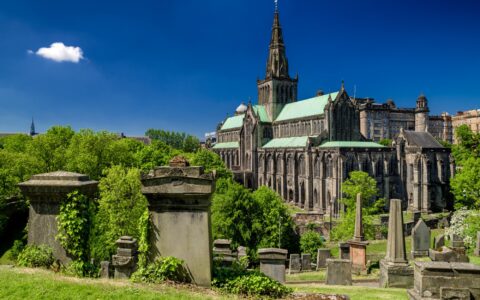St. Mungo’s Cathedral in Scotland is a Georgian architectural gem built almost a thousand years ago. Located in the beautiful city of Glasgow, the building dates back to the 12th century, and is one of the region’s must-see tourist attractions. A remarkable Gothic cathedral, famous for its solid oak vaults!

La cathédrale Saint Mungo – © Jaroslav Moravcik
The building is thought to date back to 1136, when it was founded by King David I of Scotland. The cathedral was named after the patron saint of the city of Glasgow, Mungo (also known as Saint Kentigern), who was famous for having built a small church on these very premises over 700 years ago, before the new cathedral was built.
Little is known of the original structure, except that it was built of wood and destroyed by fire in 1249.
In 1250, a new stone cathedral dedicated to St. Mungo was built. It was much larger than the previous structure, and was the tallest building in Glasgow at the time.
In the 16th century, the cathedral was enlarged and remodeled in the Gothic style. The building was further extended in the 19th century, with the addition of a south aisle and spire.
Restoration to current colors was undertaken by William Burges in 1871, and the cloisters were rebuilt to the original Gothic architecture around 1830.
The cathedral was designated a free church in the 1880s, when the majority of the Scottish people turned against the establishment of the Church of Scotland.
A number of changes were made to the cathedral at this time, including a new pulpit, a new organ and the addition of stained glass windows. It was also the first time the building was called “St. Mungo’s Cathedral”.
St. Mungo’s Cathedral is one of the few Scottish cathedrals to have escaped the Protestant Reformation of 1560, and many locals protected it from the violence of the time, regarding it as a national treasure.
St. Mungo’s Cathedral is an impressive Gothic structure, its tower visible from many parts of the city.
The interior is adorned with magnificent stonework, stained glass windows and a wooden ceiling. While the exterior is made of red sandstone, the interior of the cathedral is made of richly decorated wood, adding a sense of warmth to the space.
The building is very large, with a seating capacity of 2,000. The nave is remarkably large, with plenty of space for visitors to walk freely and admire the architecture.
The cathedral boasts many remarkable features. Starting with a magnificent stone rood screen overlooking the Gothic choir. This magnificent structure dates back only to 1889 and includes no fewer than 25 statues representing crucified Christian saints.
A true marvel!
As for the Choir, it is one of the most remarkable specimens of Scottish medieval architecture. Inside, the artistic illuminations are very beautiful and are once again the result of restoration work carried out in the 19th century.
The Gothic Choir is considered by many to be the cathedral’s main attraction.
St Mungo’s Cathedral also boasts a 12th-century crypt beneath the Gothic choir. It houses the royal tombs of Robert I (Scotland’s first king) and his wife Elizabeth Bruce, as well as those of former bishops. It is also famous for containing the tomb of Glasgow’s own patron saint: Saint Mungo.
One of the most striking features of St. Mungo’s Cathedral is its ornamental carvings. There is an abundance of carving on the exterior and interior of the building, including gargoyles and grotesques, foliage motifs, masks and human and animal figures.
Many Scottish symbols are present in the cathedral, including thistles, the saltire and pineapples. The pineapples are thought to date back to the 17th century, when King James II presented the cathedral with a pineapple to thank the people of Glasgow for their hospitality during his exile.
The cathedral’s stained glass windows are another architectural feature worth admiring. Twelve different stained glass windows were made especially for St Mungo’s Cathedral, with themes ranging from the life of Jesus to Celtic art and culture.
The Rose window is one of the most impressive, with intricate patterns and a central image of the Virgin Mary. The large stained glass window above the altar depicts St Mungo, the cathedral’s namesake.
The ornate organ at St. Mungo’s Cathedral is another architectural and artistic highlight. The organ was first installed in 1864, and was completely rebuilt in 2004 and 2005.
With 1,832 pipes, it is one of the largest organs in the world. The organ is played regularly, with concerts taking place on Wednesdays at 7pm from October to May, and on Saturdays at 3pm from June to September. The organ is also used as part of regular worship at the cathedral, most notably during the Evensong service.
This service takes place at 5:15 p.m. on Sundays from October to May, and at 4:30 p.m. on Sundays from June to September.April 1 to September 30: Monday to Saturday, 10am to 5pm. Sundays, 1pm to 5pm – Last admission 4:30pm.
October 1 to March 31: Monday to Saturday, 10am to 4pm. Sundays 1pm to 5pm – Last admission 4:30pm
Closed for lunch from 12pm to 1pm. Last admission at 11:45 a.m.
 Address:
Address:
 GPS :
GPS :
 Site Web :
Site Web :
 Opening hours:
Opening hours: